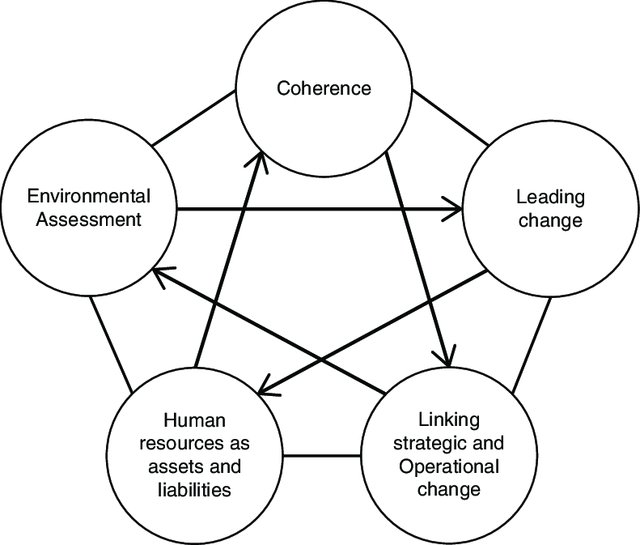Change Management is one of the most critical yet misunderstood disciplines in modern Management.
Giving a good definition of Change Management is not always an easy task. Prosci defines it as “the process, tools and techniques to manage the people side of change to achieve a required business outcome.”
My concern here is that Management should cover precisely the same elements. For this reason, I have already discussed in an article Do we still need Managers their role in relations to change.
In a VUCA world, where Change is persistent, the reality is that we constantly change. Change Management becomes, therefore, one of the main arenas where good management practices are continuously brought to test. In this article, I will try to explore the History of Change management as a discipline, as well as offer my perspective on how Change Management should be embedded as a foundational capability in any organisation. The link with Organisation Design is evident, as well as that or reflecting on Leadership and Culture in an age where Change is more critical than ever mainly as we reflect on a milestone transformation such as that imposed by Digital.
1. A Brief History of Change Management
The origins of the concept of Change Management can be traced down to the birth of the Human Relations Movement and Elton Mayo‘s work. It was him that first stressed, through his research, the importance of Communication and Leadership in ensuring that an organisation would reach its objectives. From this research stems the importance to consider the “Human Factor” in the pursuit of business results, a key element in the later development of the discipline.
1.1 The Beginnings
But there was another need: defining what really change meant. The topic is not new, having been investigated by generations of philosophers starting from ancient Greece. However, in terms of concrete applications to the modern organisational setting, the origin of Change Management is usually linked to the work of Arnold van Gennep, a Dutch anthropologist who published in 1909 the book Rites of Passage. He was the first anthropologist to note the regularity and significance of several rituals attached to the transitional stages in man’s life: birth, puberty, marriage, and deaths. These are, in all cultures, marked by ceremonies which may differ but are universal in function.
Each of these rites locks into a paradigmatic change process that he identified as happening in three states: separating from our current state, moving through a transition, and reincorporating into a future state. Today still, these three elements (As-Is, Transition and To-Be) are the core elements of every Change process.
However, the concept of Change Management would not find a specific status and definition until after the Second War War. In 1948 social psychologist Kurt Lewin introduced a similar change approach, also comprising of three phases: unfreezing, relocating, and refreezing. This approach is the first that can indeed be considered a Change Management Model. In 1969 Richard Beckhard was the pioneer that created another very relevant discipline, key in the development of Change Management models. This is Organisation Development that he defined, in his milestone work Organization Development: Strategies and Models, as “an effort (1) planned, (2) organisation-wide, and (3) managed from the top to (4) increase organisation effectiveness and health through (5) planned interventions in the organisation’s ‘processes,’ using behavioural-science knowledge.” A significant contribution from his work lies in the concept that people support what they help create. People affected by a change must be allowed active participation and a sense of ownership in the planning and conduct of the Change. In 1979 it was the time of William Bridges. This consultant has developed a concept similar to that of Lewin, but focusing on the description of the states of a transition as the ending, the neutral zone, and the new beginning.
These initial contributions are vital in elaborating an underlying understanding of how individuals and systems experience Change.
1.2 The era of Change Management
As you can see from the Google Ngram viewer below, it is, however, only after the 1990s that Change Management models and frameworks start getting established, and the concept of Change Management becomes a discipline.
Fig.1 Historical usage of the word Change Management. Source: Google Ngram
It is in this period that change management began to enter the business vernacular. The people side of Change moved out of the academic and exploratory space and into concepts discussed at project meetings, in C-Suites and around boardroom tables. Language began to form around the discipline of change management, and many of the guiding principles that still guide the discipline were articulated during this time. The first steps were taken to show that individual Change does not happen by chance, but can be supported and driven with thoughtful and repeatable steps. It is at this stage that the first models get established.
A prime example of this is the Change Acceleration Process that General Electric introduces as part of its more extensive improvement program. But many authors start writing about the concept of Change. Let’s see a few:
- Daryl Conner, Managing at the Speed of Change (1992). Here he introduced several foundational concepts and topics for the discipline, with a specific focus on resilience.
- Todd Jick, Managing Change: Cases and Concepts (1993) includes many case studies, out of which he generated his Ten Commandments of Implementing Change.
- Michael Hammer and James Champy, Reengineering the Corporation: Manifesto for Business Revolution (1993). in this book, they introduce the results of a research that shows that more than 70% of change initiatives fail, giving a strong argument for the development of Change approaches.
- Jeanenne Lamarsh, Changing the Way We Change (1995) focused a lot on resistance mitigation and the actions needed to enable Change.
- John Kotter (1995) linked the concept of Change to Leadership, first in an HBR article, then in a book Leading Change. Here he described eight change failure modes and subsequent steps to address them
- Spence Johnson with his bestseller Who Moved my Cheese? (1998) presents a parable on how individuals can deal with the Change that is happening around them and to them. He is one of the first of really drawing the attention to the individual.
1.3 Change Management as an established discipline
It is in the early years of the new Millennium that Change Management really becomes a discipline.
In 2003 Prosci launches the ADKAR model, and with it the first Change Management certification. 2005 sees the birth of the Change Management Institute, which has later released, in 2008, the Change Management Practitioner Competency Model, with a tiered accreditation scheme. In 2009 the Association of Change Management Professionals was also established to further diffuse competencies around the world.
Most consulting companies, large and small, have embedded Change Management in their product catalogues. Every project has presented with its line of Change Management effort. Yet, it seems that the original estimate by Hammer and Champy of a 70% failure in change initiatives, might be still valid today. Why? Because we still see Change Management as a separate activity, often limited to a newsletter and a few cute posters, and easily the first to be cut away when budget restrictions surge.
1.4 Relationship with other disciplines
There is often confusion between Change Management and other organisational disciplines, particularly because often there is an overlap in methodologies, tools, competencies. Here the main areas of overlap:
- Project Management. Because often Change Management is embedded into implementation projects (usually about technology), there is often an overlap with Project Management as a discipline, which makes many Project managers (particularly the less experienced ones), that just adding a Change Management line in their project management plan is sufficient. However, the specific importance given to Change Management as a discipline offered by the most critical Project management institutions is probably the best sign that this confusion should not exist.
- Organisational Development. I often see this overlap in companies where HR is expected to develop Change Management skills. As Naomi Stanford points out, however, the two disciplines are different in the way that “change management’ is about supporting planned Change that is delivered through a formal project – often a technology-based one – so it has a defined scope while ‘organisation development’ is about ‘the activities engaged in by stakeholders in order to build and maintain the health of an organisation as a total system. It is characterised by a focus on behavioural processes and humanistic values. It seeks to develop problem-solving ability and explore opportunities for growth“.
- Organisation Design. Also, here there is the risk of overlap. Here the problem often lies in the perception that Organisation Design could be a self-sufficient discipline. Too often, reorganisations are projects that have the absolute need for a robust Change Management support plan. But unfortunately, there is often a lack of specific competencies, especially when the same HR professional or consultant is expected to know a bit of everything.
1.5 Understanding Change
Before moving into the Change Management Models I will be suggesting, there is one last point that we need to touch. Often we jump immediately into analysing what the best model for a specific project is, without considering first what Change really is.
Change, after all, is only another word for growth, another synonym for learning, we can all do it, if we want to.
Charles Handy
Change is a process that is natural and happens continuously. So why would we need tools to manage it? Because there are different types of Change, that affect us, as humans, in different ways. For example, we can think in terms of Planned Change but also of Emerging Change, as sometimes change simply happens.
It is for this reason that Andrew Pettigrew argues that to understand the Change you need to understand “the process of Change in context“. He suggests that we need to analyse three aspects of Change:
- Context – the environment in which it is happening.
- Content – what the Change is.
- Process – the way the Change is being implemented.
He then furthers his approach in a holistic view of five central factors that should be thought of when thinking of Change.

To sums things up, whenever we approach Change Management, we should be thinking of five elements.
- Context – the environment in which Change is taking place
- Content – what the Change actually is
- Process – the activities and approaches being applied to manage Change relevant to the context and content
- People – their view on Change, their ideas and commitment
- Purpose – apparent reason of why the Change is taking place, to help realise the benefits of change management.
This not just to choose the most appropriate methodology and model, but also to plan the Change Management intervention, and above all, understand the support model that needs to be put in place.
2. Adopting Change Management Models
managing Change needs to become part of the way each Manager and Business Leader operates. All supporting functions in an organisation (HR, IT, Finance, Operations) should help and support with their internal knowledge and discipline. From my point of view, there should not be a plethora of “Change Agents”, but rather a model in which every team is responsible for its own Change Process.
Over the past weeks, I have dedicated several articles on the main Change Management Models that I have come to appreciate in my work. There are many more out there, so this is only a partial list. There are different types of Models, so I have grouped them in three specific sections.
2.1 Change Management Models that Support Visioning and Planning
Few Change Management Models support the entire Change Management process, including what I define as “Visioning”, i.e. the definition of Plan and Vision of where we aim for. These Models will typically support the definition of the entire Change Management Project Plan and are therefore often overlapping with Project management methodologies. Primarily these model include the step about deciding what to change and not just how.
2.2 Change Management Models that focus on the Change Path
The Models that are more diffused are instead focusing specifically on the Change Path. These are models that intervene after the decision to Change has been taken, and help govern and understand the process to get there.
2.3 Change Management Models that focus on Resistance
There are a few models that instead concentrate rather on the individuals in their process and the reasons for why they might resist changing. As such, they tend to focus on preventing or at least understanding behaviours. These models typically don’t provide support in the definition of a Change Plan, but rather do complement typical project management approaches in the identification and Management of Resistance.
Conclusion
Change Management, as a discipline has evolved a lot over time. To me, it should, however, be considered a vital task of every manager, and not a side activity implemented solely during a Change Initiative. In a VUCA environment, we need to embed most of the tools mentioned above in our daily work as managers. And not wait for a formal process to start. Which is why I have referred these tools individually as a resource for every manager. After all, taking care of the Human Factor is one of the critical necessities we need to consider.
Ernest Hemingway wrote that Change happens in two ways: “Gradually, then suddenly.” This is the vital concept that we need to ensure we understand through the realms of this discipline. Whether you are a Project Manager, a Scrum Master, an entrepreneur or a line manager, acting on Change is a critical aspect of your job. And the approaches I mentioned should be considered as your primary “toolkit” to succeed in the post.

Cover Photo by Ross Findon on Unsplash











[…] Change Management: The 10 Best Approaches & Models […]
[…] Change Management: The 10 Best Approaches & Models […]
[…] Change Management: The 10 Best Approaches & Models […]
[…] Change Management: The 10 Best Approaches & Models […]
[…] Change Management: The 10 Best Approaches & Models […]
[…] Change Management: The 10 Best Approaches & Models […]
[…] Change Management: The 10 Best Approaches & Models […]
[…] Change Management: The 10 Best Approaches & Models […]
[…] Change Management: The 10 Best Approaches & Models […]
[…] Change Management: The 10 Best Approaches & Models […]
[…] “Bridging the Gap” becomes, therefore, the expression to fulfil the difference between AS-IS and TO-BE. Which is why this concept is often used in Change Management programmes. […]
[…] Change Management: The 10 Best Approaches & Models […]
[…] Change Management: The 10 Best Approaches & Models […]
[…] Change Management: The 10 Best Approaches & Models […]
[…] Change Management: The 10 Best Approaches & Models […]
[…] Change Management: The 10 Best Approaches & Models […]
The Ernest Hemingway quote about change happeninng gradually, then suddenly is … so simple and so true.
[…] Change Management: The 10 Best Approaches & Models […]
Why does no one ever mention the (Warner) Burke-Litwin (George) model?
It is one of the most useful transformation frameworks I have ever used.
[…] Change Management: The 10 Best Approaches & Models […]
[…] Change Management: The 10 Best Approaches & Models […]